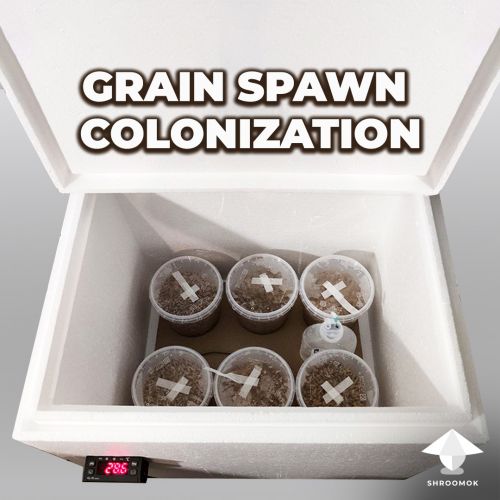
STEP 7. Day 3 - 14. Incubator for psilocybin mushrooms. Colonization conditions. Colonization problems
After inoculation you need to prepare incubator for the first step of growing psilocybin mushrooms — colonization period. This will help mycelium formation and successful colonization of the substrate.
Those who are just starting their way in growing mushrooms make a lot mistakes, in particular — not observing the temperature. Temperature decrease in 4-5 degrees from the recommended temperature abruptly stops or completely stops the mycelium growth.
The right temperature can be achieved in an incubator.
Stages of psilocybin mushrooms cultivation
Let me remind you that the whole process of cultivation psilocybin mushrooms is divided into 2 main stages:
1. Colonization period (first 2-4 weeks). It is vegetative phase when mycelium of psilocybin mushrooms is formed. This mycelium grab the nutrient substrate in the jars or spawn bags. We need an incubator for this phase.
2. Fruiting and harvesting period (next 6-8 weeks after colonization period). It is a phase of pinhead and primordia formation, mushrooms fruit bodies growth and harvesting. We need a growbox (aka fruiting chamber) for this phase.
Incubator vs Growbox. What is the difference between incubator and growbox?
Very often newbies confuse an incubator with a growbox. That's why there is misunderstanding with the necessary conditions.
Growing conditions for each period are different. Let's sort it out right!
✅ Incubator for mushrooms — is a special box or cabinet used at the first stage of growing - colonization period of growing mycelium. In the incubator should be:
- WARM - it is simulation of hot dry season in a wild. The temperature is maintained at +27°...+29°C or 80-84°F. If it is lower - mycelium won't grow. If higher - it harm mycelium or substrate will be covered with a dense mycelium called overlay.
- DRY - low relative humidity, about 30-55%. In fact, it's room humidity without additional humidification. So that, we simulate a period of drought in nature.
- DARK - no light at all. Light can be harmful for mycelium during colonization period. Mycelium must "think" that it's natural underground conditions.
🔴 Growbox (aka fruiting chamber) for mushrooms — is a special box used at the second stage of growing - fruiting period of mushrooms growing - after incubator. In the growbox should be cool (+21°...+23°С or 70-73°F), high relative humidity (85-99%), diffused natural light or LED light (12-16 hours).
Misunderstanding and confusion, particularly with the temperature mode, is so common that some newbies criticize us for our advises. Like: it shouldn't be such a high temperature, in other guides and forums write otherwise.
Another part of the newbies often complains that he did everything according to the guides, keep the jars at a temperature of +21°...+23°C or 70-73°F, and mycelium does not grow at all or develop too sluggish and slow.
In fact, the confusion comes from misunderstanding and ignorance of the separation of growing periods. As a result, misunderstanding with growing conditions for each period.
Dear Friends! These stages and different conditions for each stage were invented not by us, but by Nature thousands and thousands years ago. To understand why the cultivation of psilocybin mushrooms is arranged in this way, it is enough to analyze the conditions of tropical and subtropical climates. The places where most of the strains of psilocybin mushrooms come from. Even their names speak for themselves: Mexican, Brazil, Amazonian, Hawaii, Thai, Cambodian, Nepal, Argentina, Panaeolus Cambodginiensis, Panaeolus Cyanescens Jamaica and others.
Therefore, a higher temperature +27°...+29°C or 80-84°F is needed for colonization period and it encourages vegetation. Thus, we mimic the hot dry period of the tropics/subtropics for the fungus. During this period mycelium develops in moist soil underground or in moist grain substrate in our jars.
While for fruiting period, we decrease the temperature to +21°...+23°C or 70-73°F and simulate a long rainy season with high humidity in the growbox and rehydration. Thus we phase out the vegetative growth of the fungus and provoke it to the pinhead and mushrooms formation. In the imitation of such conditions we are helped by a growbox. For the mushroom, damp air after a rain and a drop in temperature is a sign that it is time to release spores, and to do this it is necessary to form the mushroom fruit body.
We'll figure out how to make a growbox and provide the necessary conditions for fruiting in the DIY Grow Box for Magic mushrooms and Pinhead initiation and Growing parameters sections.
But now substrate in the jars after inoculation needs an INCUBATOR!
How to make simple Incubator for Psilocybin mushroom growing
As an incubator could be a closet, any cardboard box, cabinet, a plastic box, an old refrigerator, a bedside table, just a corner near radiator or even a shelf in your closet.
1. In our case, it is an ordinary cardboard box, which is completely closed, so that there is no light access. It is wrapped with bubble wrap inside to retain heat.
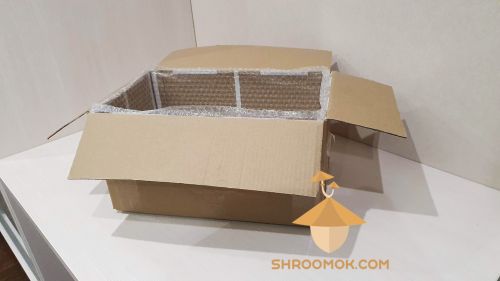
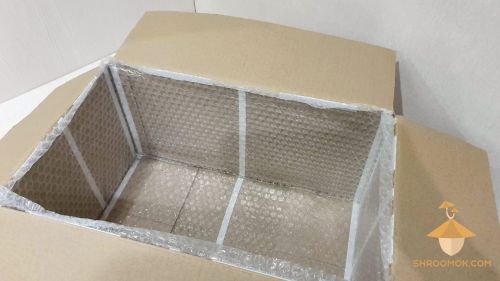
Styrofoam box as incubator for mushroom cultivation.
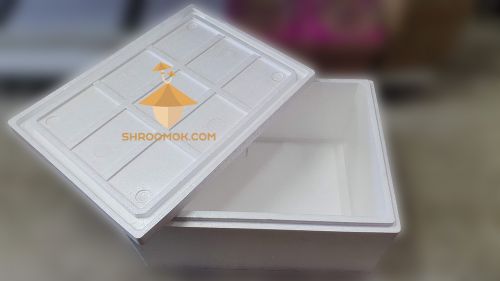
Cabinet shelf or cupboard shelf as incubator for mushroom colonization period in hot summer period.

2. Place heater in incubator. For example, shoe dryer, thermal cord, electric spirals or any other option to maintain the incubator temperature +27°..+29°C or 80-84°F. Optimal temperature is +28°C or 82°F.
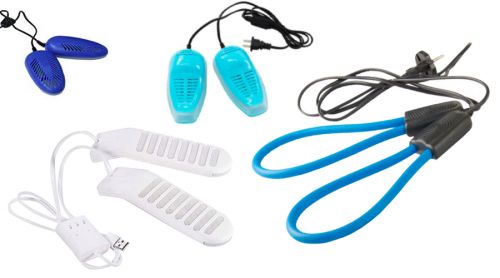
Shroomok's Choice on Amazon:
Heater for incubator and Boot Dryer - $15.99
Heater for simple incubator and Shoe Dryer - $50.23
Any mat heater (silicone mat heater, heat mat for terrarium, floor mat heater, plant and seed warming mat, hydroponic heating pad for indoor seedling and germination), animals bed heater, any household heater or any heating element, сorner near radiator or even your cat.
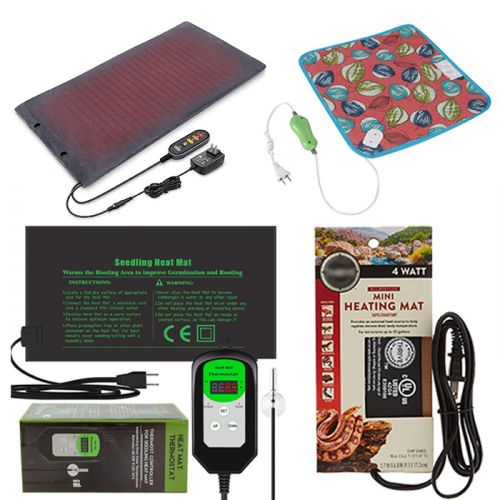
Shroomok's Choice on Amazon:
Heat Mat and Digital Thermostat Combo Set - different sizes - $29.99
🔴 The heater may not be needed at all. It depends the season of the year and temperature conditions at home
3. Add thermometer to monitor the temperature. At first, we used an ordinary household thermometer (white on the photo), but this is not convenient.
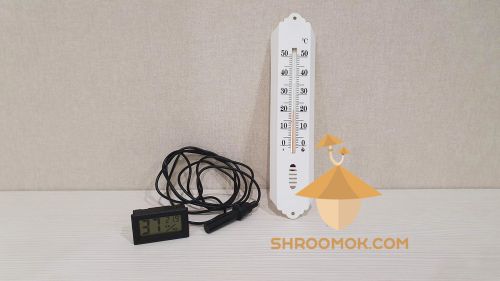
Every time for checking the temperature we need to open the incubator. The temperature in incubator quickly decrease to room temperature. It was quite inconvenient for us and not good for mycelium.
That's why we recommend to use external electronic thermometer with hygrometer. The hygrometer will be very helpful later to control the humidity in the grow box. Or use Digital devices all-in-one.
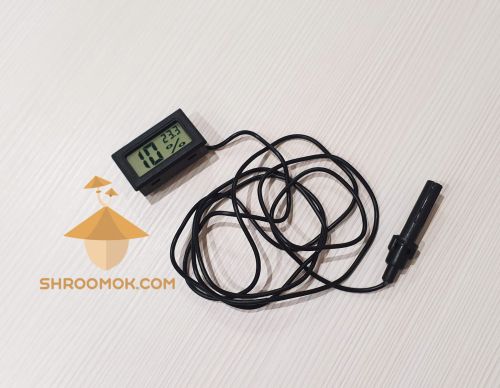
Shroomok's Choice on Amazon:
Bluetooth Digital Hygrometer, Thermometer with Remote App - $12.99
Or more complicated devices with CO2 detector. They are more expensive, but show the whole picture of air quality. Will be useful for fruiting period in the future.
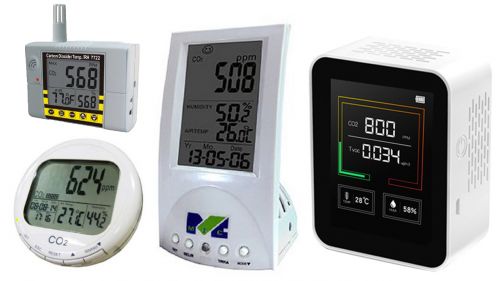
Shroomok's Choice on Amazon:
Digital Air Quality Monitor - Temperature, Humidity, CO2 $45.99
Here is a simple DIY incubator box after inoculating the first batch of substrate.
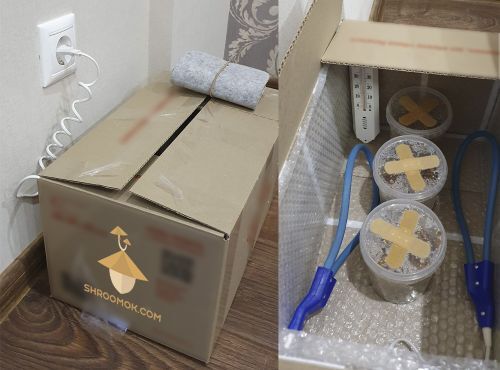
4. Put all jars in it after inoculation. Put the heater, thermostat and air quality sensor or thermometer inside the box as well.
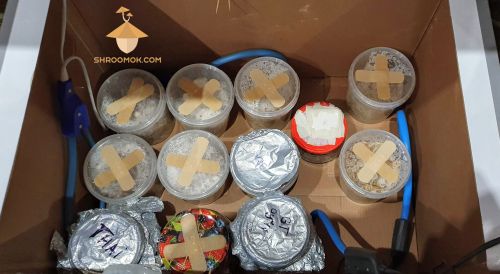
❗️Heater or Heat Mat shouldn't contact with jars directly!
5. Close the incubator to ensure dark and warm conditions in it. You can cover the incubator with a towel or blanket. It depends on season of the year and your temperature conditions at home.
Incubator is ready! All the fuss is behind. Now it's time for patience and observation. Control incubator conditions and just wait.
How to make Incubation Chamber with automated temperature control for mushroom growing
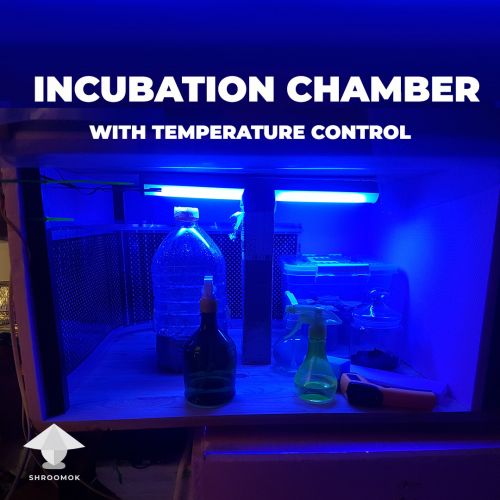
Incubator with thermostat for those who want to make great automated chamber for colonization period and use it for a long time
🔴 Check out guide: How to build automatic incubation chamber for mushrooms
Peculiarities of colonization period
At this stage, your main task is to keep a close eye on the temperature in the incubator. Starting from the 3rd day after inoculation carefully check the jars for the presence of mycelium or any other living creatures (look and smell).
Be careful with the jars at the very beginning. Excessive shaking can be harmful for mycelium and significantly prolong colonization period.
How long does it take to fully colonize the substrate? From 2 to 3 weeks after inoculation mycelium completely covers the entire substrate in the jars (if all necessary conditions are met).
COLONIZATION MUST PROCEED AS RAPIDLY AS POSSIBLE TO PREVENT OTHER ORGANISMS FROM BECOMING ESTABLISHED.
When can you observe the first signs of mycelium? In 5-7 days after inoculation you may notice the first signs of fungal life. If you used an antibiotic in a liquid spore, this process can take up to 10-14 days.
Here you can see the first signs of mycelium. 5 days after inoculation. Psilocybe Cubensis Thai on wheat substrate.
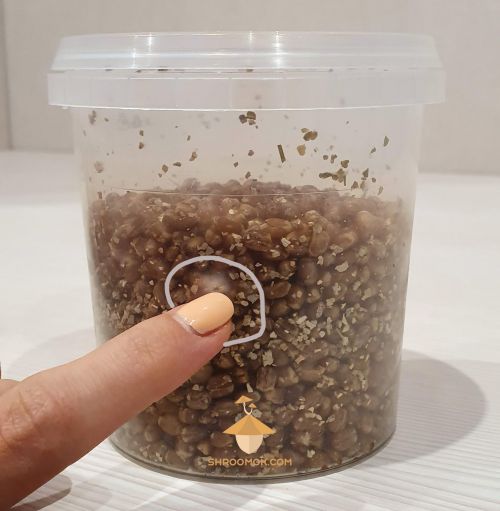
The results of the experiment "Antibiotic in liquid spore syringe 3 hours"!
Mycelium in the jar with antibiotic (overdue 3 hours in liquid spore) appeared on the same day as the rest of the jars. To be exact on the 6th day after inoculation. Dynamic of grain coverage by mycelium with no difference from the other representatives.
In our case, antibiotic overexposure had no effect on mycelium overgrowth. Anyway, I don't recommend overexposing the antibiotic in the liquid spore more than one hour!
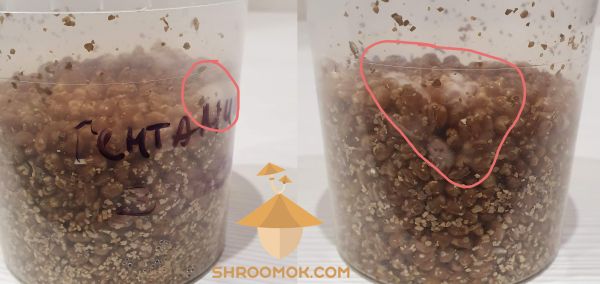
The first signs of Psilocybe Cubensis Golden Teacher appeared on the 6th day after inoculation (wheat substrate).
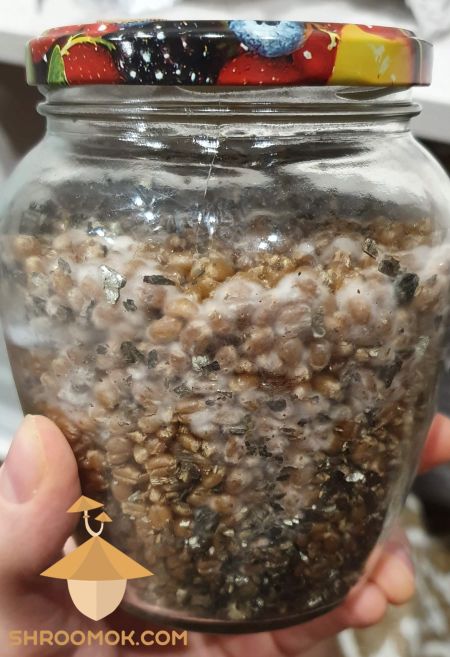
The first signs of Psilocybe Cubensis Brazil, 7th day after inoculation (oat substrate).
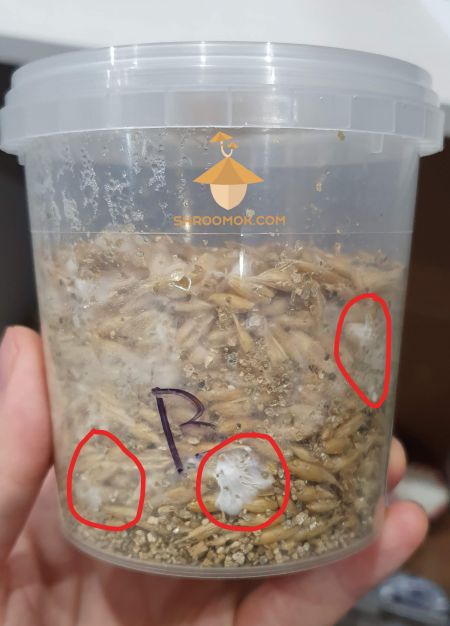
Mycelium covered 50-60% of the grain in 10 days after inoculation. As you can see, the mycelium covers the grain unevenly. It is mainly concentrated at the points where the liquid spore fell during inoculation. Therefore, it's time to shake such jars.
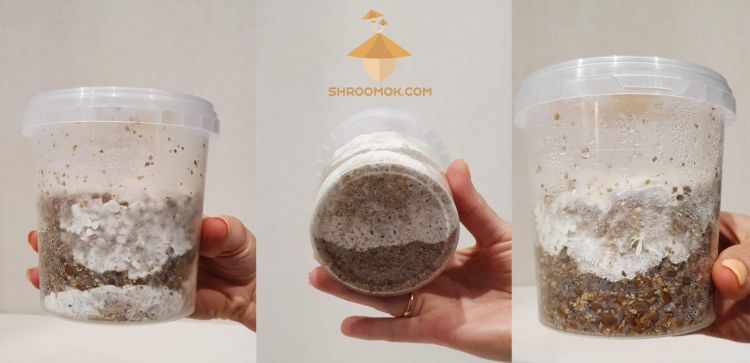
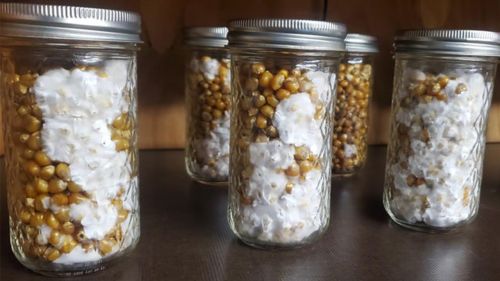
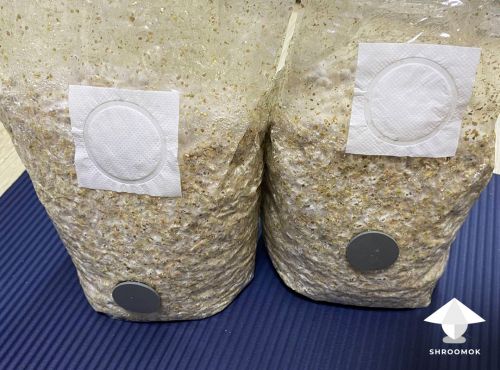
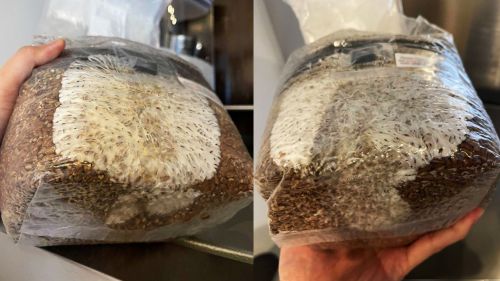
Why do you need to shake the jars?
It is necessary to spread mycelium evenly throughout the whole substrate. Uncovered grain cannot be used in the future. Without mycelium it will become sour and mold will settle on it.
When we need to shake the jars? When 50-70% of the substrate is already covered with mycelium. At this stage mycelium is already strong enough. If you shake it earlier (20-30%) - mycelium can be very weak, it will not survive after shaking and can stop its growth.
How to shake? Take a jar and methodically tap it on all sides with your palm or fist. You need to ensure that the mycelium clot breaks into individual grains and mixes evenly with uncovered substrate. This will be quite problematic if there are more than 3/4 of the grain in the jar. This is the main reason why we fill the jars no more than 2/3 or 3/4.
After shaking the grain, it may seem that there is no mycelium in the jars at all, but don't worry, it's ok. In 2-3 days mycelium completely fill all substrate in the jar.
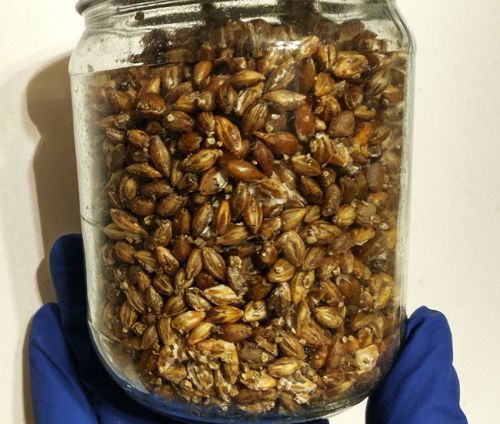
If the mycelium evenly covered the substrate then don't shake it. Here is an example of such jars below (strain F+):
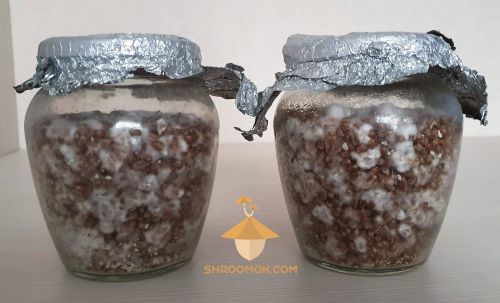
Growing problems during colonization period
There are 2 main causes of growing problems in the colonization phase:
- Contamination.
- Improper colonization conditions.
The main types of psilocybin mushrooms contamination are:
- Bacteria.
- Molds and parasitic fungi.
- Viruses.
In this section, we share the most common problem cases in the colonization phase.
Check out our full guide of all possible contaminants and growing problems on all stages of mushroom cultivation in the Contams & Troubleshooting section
Now let's figure out what could go wrong during the colonization period.
Main causes of Bacterial contamination. How to recognize bacterial contamination
🔴 Overcooked grain substrate and improper conditions of substrate cooking. As a result, the substrate can become sour. A small amount of overcooked and fully expanded grains can be handled by the psilocybe mycelium. If, however, bacterial contamination takes over the overcooked areas - throw away the whole jar! There is no chance to save it!
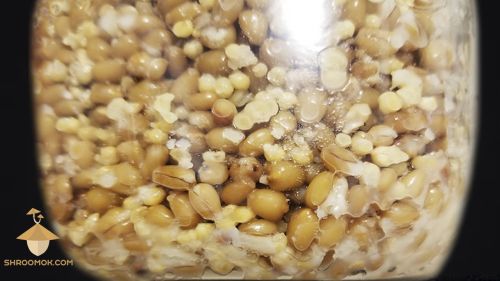
🔴 Excessive moisture in the substrate can cause bacterial and mold fungus contamination. A clear indication of excessive moisture is drips where the grains touch the jar, water drips and large drops above the substrate. Normal substrate moisture is considered to be the presence of light misting/sparking/fogging/aerosol in the jar.
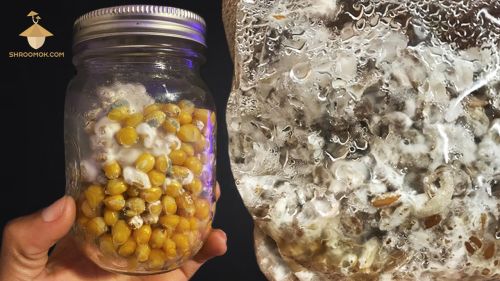
If the substrate is still healthy this situation is solved by shaking the jar. If there is enough vermiculite at the bottom of the jar (at least 5 mm), it will absorb excess moisture. That's why we recommended to cover the bottom of the jar with a layer of dry vermiculite, and then put the substrate in the jar (check the Substrate sterilization section).
However, if on the substrate, around the drips and on the bottom of the jar you can see cloudy bacterial halos, mold, or appeared barely perceptible sour-sweet smell from the air filter - throw it away!
🔴 Slime on the mycelium or substrate is a common sign of bacterial contamination. Yellow-gray-brown mucous rings are often formed in the areas where the substrate touches the jar and condensation is present. A gel like fluid or crust may be found, which is also a bacterial contamination sign. Move to trash such exhibits immediately!
The most common species is the Bacillus subtilis. It is the most resistant to high sterilization temperatures. As well as Bacillus cereus and other strains.
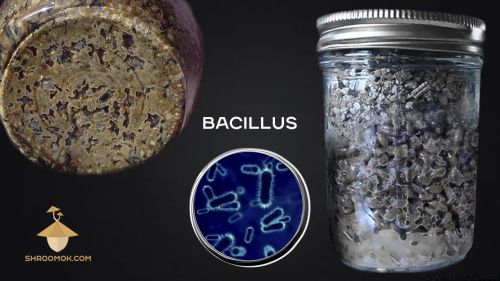
🔴 The odors in incubator is a clear sign that one of the jars has to be thrown away. You open your incubator and you feel there's a spy somewhere. You should smell all air filters to check all jars for any odors that are differ from the smell of forest mushrooms.
If through the air filter you feel a smell of something fermented/rotted/cider/sweet and sour/stale/ yeasty/smell of dirty socks — those are clear signs of bacterial contamination, specifically Bacillus subtilis. Such jar should be trashed immediately to avoid contamination spreading to neighbor jars.
🔴 Metabolites (aka mushroom exudate or mushroom piss). It is a yellow-orange liquid without any odors. It is a natural immunity reaction of mushrooms to bacteria or any other competitors. Metabolites is not a contamination itself, but their presence means that mycelium struggle with competitive microorganisms.
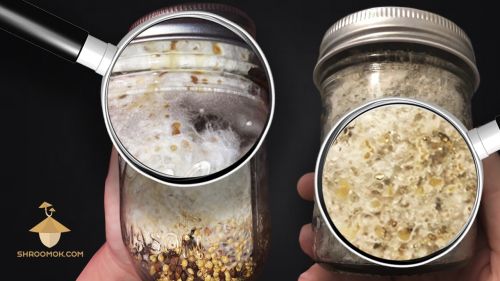
Here I can reassure you. Presence of metabolites is not a reason to throw the jar away. Mycelium of psilocybin mushrooms can successfully deal with mild contamination. But if metabolites are accompanied by subsequent color/smell changes in the substrate and mycelium - alas, you have to say goodbye to such jar.
🔴 Mycelium sectoring. In this way, bacteria/molds and psilocybe mycelium can temporarily share territory and useful nutrients in the substrate. Since we are dealing with two different microorganisms that compete with each other, usually clear boundaries form between them where they cross (sectors). The bacterial contamination will look more dull and faded (beige-gray color) compared to the bright snow-white mycelium of psilocybe mushrooms. Unfortunately, you need toss such jar!
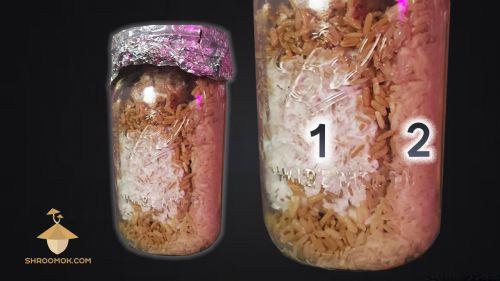
How to prevent bacterial contamination?
The cause of any bacterial contamination is neglect and improper preparation conditions for substrate.
Any bacterial contamination is the way to trash. It's impossible to treat it. But you can prevent cultivation problems are listed above. How?
We always recommend to soak grain for 24 hours, use an antibiotic or hydrogen peroxide solution in Substrate preparation section, follow exactly Cooking substrate section and thoroughly make Substrate sterilization - all these steps is a key to healthy and successful magic mushroom crop.
How to recognize mold contamination
🔴 Molds contamination is the most common failure in mushrooms cultivation, especially on the first attempts. How to identify molds during colonization period? Main signs of such contamination are:
⛔️ Texture changes. The presence of a powdery texture or powdery layer that coats the substrate or mycelium distinguishes mold from bacterial souring.
⛔️ Color changes. Blue-green, green, olive, violet, red, pink, orange, brown, gray, black spots on the substrate and mycelium are different kinds of mold. If you see it in a jar, throw it away immediately! Toss it with the jar, without opening!
Don't allow molds to spread in the air! Even if near mold there is healthy psilocybe mycelium in the jar - it's impossible to take healthy mycelium away and throw contaminated parts away! Mold spores spread easily and imperceptibly over the substrate, psilocybe mycelium, in the air, and on surfaces. Throw the whole jar away immediately to avoid contaminating neighboring jars!
The following molds appear most often on the substrate:
💢 Blue-green mold is the Penicillium fungus. One of the most widespread species. We can often see this mold on fruits and bakery. Some of its species are used in cheese-making. It is not toxic to humans.
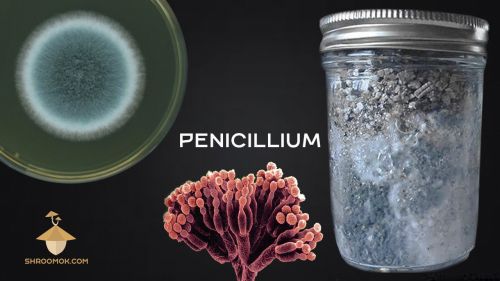
💢 Green mold is Trichoderma (Trichoderma viride particularly). At first it forms a powdery or cotton-ester mass of white color. As the spores mature, they turn green. It is also called forest mold because of its ability to break down cellulose. There are about 15 other species of Trichoderma. Although, Trichoderma is less common indoors, but spores are quite aggressive. Which makes it one of the most common contamination in mushroom cultivation. It is not toxic to humans.
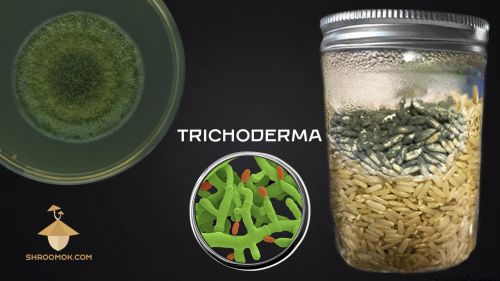
💢 Black mold is black Aspergillus. Black mold can be found on the walls of damp rooms. It is toxic and causes human, animal and plant diseases. This mold usually very visible, it can't be confused with anything. As soon as you see it, throw the jar away immediately. Don't endanger other jars and your own health.
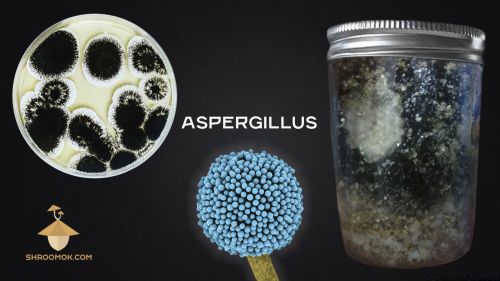
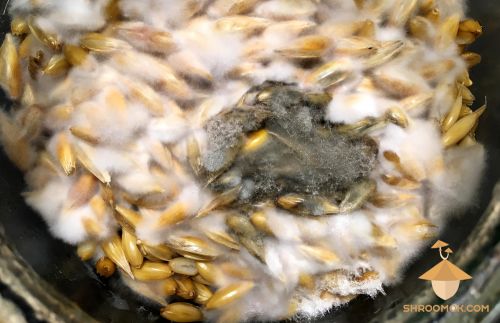
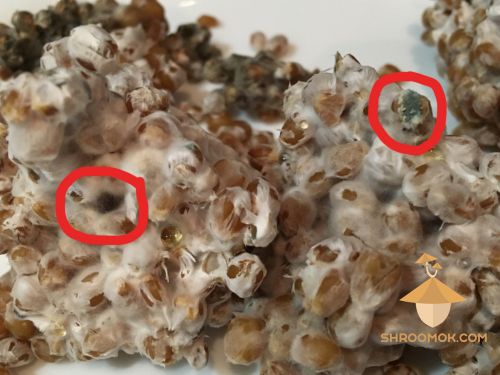
Causes of mold contamination and how to prevent molds
Typically, molds contamination appear due to POOR STERILITY and neglect substrate preparation steps: Substrate preparation section, Cooking substrate section and Substrate sterilization.
Only patience, pressure cooker and sterility!
🔴 Check out more guides: Mushroom Growing Troubleshooting
Mistakes and Improper colonization conditions
🆘 Why I can't get my mushroom to colonized? No signs of mycelium growth in 10-14 days after inoculation. Why mycelium grow too slow?
The most probable causes:
⛔️ Low incubation temperature. The t° in the incubator below +27°...+29° C, as well as sudden temperature changes and temperature fluctuations. Growers often confuse the conditions of the colonization period (incubator) and fruiting period (growbox). Instead of the recommended temperature of +27°...+29°C, they wait for mycelium to appear at +21°..+23°C. Mycelium either does not appear at all, or develops too slowly. Because of the growth delay, mycelium does not have time to get stronger, and the substrate is taken over by competitive microorganisms. Let me remind you that the colonization period in an incubator requires a higher temperature of +27°...+29°C, which stimulates vegetation. If you delay with substrate colonization, it will be taken over not by psilocybin mycelium, but by contaminants.
⛔️ Insufficient cooling the substrate before inoculation. Inoculation into hot substrate leads to the death of spores. Spores and mycelium die at temperatures slightly above forty degrees. Therefore, it is highly important to cool the substrate to room temperature.
⛔️ Too dry or undercooked substrate. There is not even sweat on the jar. You can try to add sterile water with a syringe through the inoculation port and stir. This is a rather rare case. It is a serious disrupt of the process of preparing the substrate and sterilization. In such conditions, the mycelium may not grow at all or grow slowly, painfully and dry out.
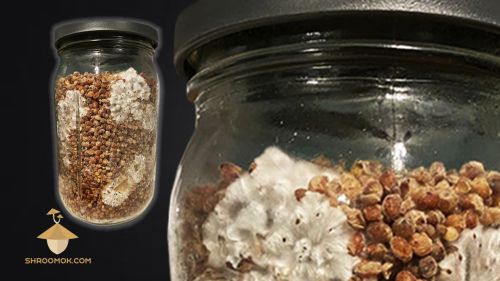
⛔️ Too wet. Free water and drips in the jar are bad. Misting/fog/aerosol on the sides of the jar is normal. If there is no vermiculite at the bottom to equalize the moisture balance, be ready to toss such jar or bag. Check out Substrate preparation section, Cooking substrate section and Substrate sterilization.

⛔️ Antibiotic in liquid spore syringe for a long time. We've already mentioned that antibiotic affects not only the contaminants, but also the viability of psilocybin spores. That's why it's not recommended to keep the antibiotic in liquid spore solution for more than an 1 hour before inoculation. Usually 20-30 minutes is enough. Details in Inoculation section.
⛔️ Excessive concentration of antibiotic in the liquid spore. Recommended dosage: 1 ml of antibiotic per 10 ml of liquid spore solution. No more! See Inoculation section for details.
⛔️ Excessive shaking the jars in the first days can significantly prolong the colonization period.
⛔️ Lighting and sunlight are destructive for mycelium during colonization period.
⛔️ Poor spore print quality. Old spore print with non-viable spores, improper storage conditions of the spore print, degeneration of strain genetics.
⛔️ Poor grain quality. Grain that was treated with chemicals, pesticides and contains heavy metals is not suitable for food or for the mushroom cultivation.
⛔️ A competing life form is stealthily developing in the jar. It suppresses the growth of psilocybin mycelium. Contaminants could have gotten in at any stage: from the spore print, remaining in the substrate due to insufficient sterilization, or getting in during inoculation. There is nothing to be done here, sooner or later they will show themselves, and the jar will go to waste.
🆘 Why mycelium stop growing after shaking the jars?
⛔️ This happens if the mycelium is still weak and not strong enough (20-30% of grain covered with mycelium). It is worth shaking the substrate when 50-70% of the grain is already covered by strong mycelium of psilocybin mushrooms.
⛔️ The second reason can be the activation of competing microorganisms after shaking, which are evenly distributed together with the mycelium of psilocybes and suppress it. Sooner or later, contaminations will show itself.
When Grain Spawn ready for Spawn to Bulk
Usually colonization period complete in 2-3 weeks after inoculation.
For the next step we need to choose jars with healthy 100% colonized mycelium. Grain substrate should be covered completely with healthy snow-white mycelium.
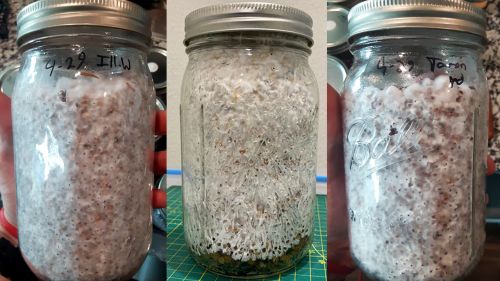
Then spawn jars/bags are ready for any tek for your choice: PF-tek cakes, small mushroom cakes or spawn to bulk for MonoTub, shoeboxes or bottle-tek growing. All these teks (except PF-tek) are required Spawn to Bulk step we are going to discuss.
Move on — Step 8. Making mushroom cake, spawn to bulk, and casing of mushroom cakes 🔽


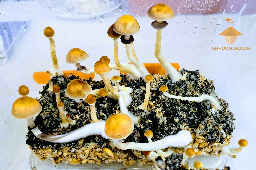
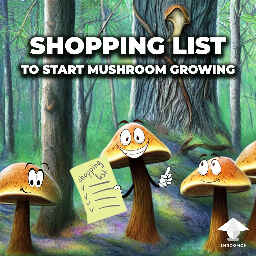
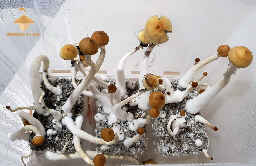
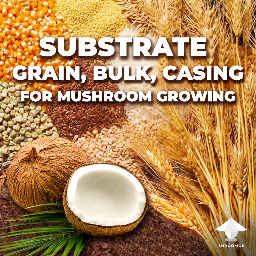
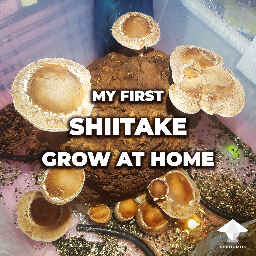
Comments
Hi there, is there a recommended CO2 level not to exceed for the incubation period? I see 600-800 for fruiting maybe?
Thanks for great website.
Hey @Flatty!
For incubation period we don't need fresh air exchange. Air filter on your jar/bag is more than enough (for gas exchange) and CO2 for this period is necessary for mycelium development!
You're right, 600-800 ppm - for fruiting period, fresh air initiate fruiting
FAE? How can u get fewsh air when using a lid on a Styrofoam box?
Hey @Dude we have 2 main periods in mushroom cultivation: colonization and fruiting.
We use styrofoam box as an incubator for COLONIZATION period (to boost and speed up mycelium growth on grain substrate in jars/bags). We don't need FAE here. We need FAE for FRUITING period in fruiting chamber (i.g. growbox or monotub).
You can learn the difference between an incubator and a fruiting chamber on this page at the very beginning ;)
I’m in a place with fluctuating temperatures and was curious if I could use a dehydrator on the lowest temp (85ish) as an incubator?
Add comment